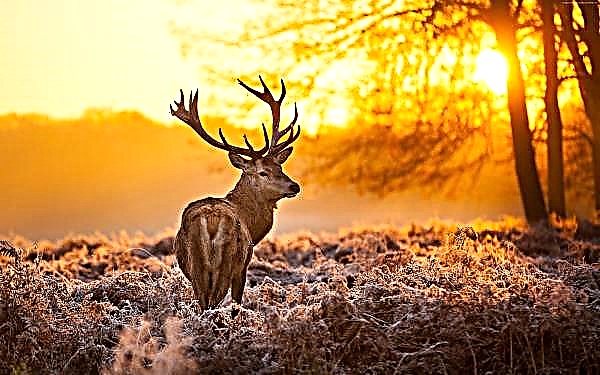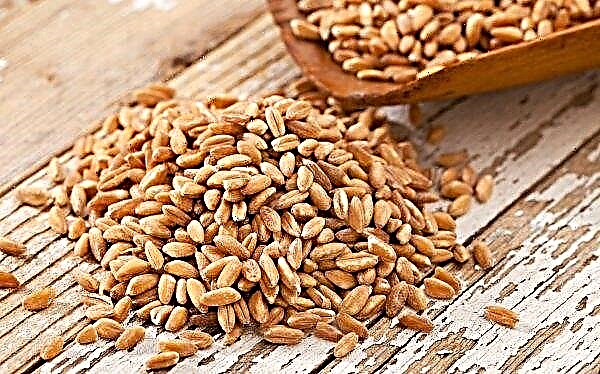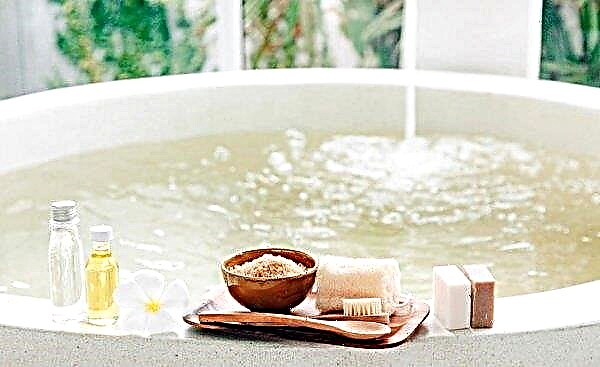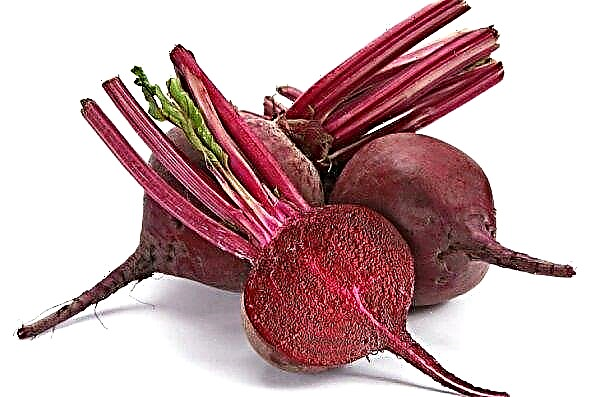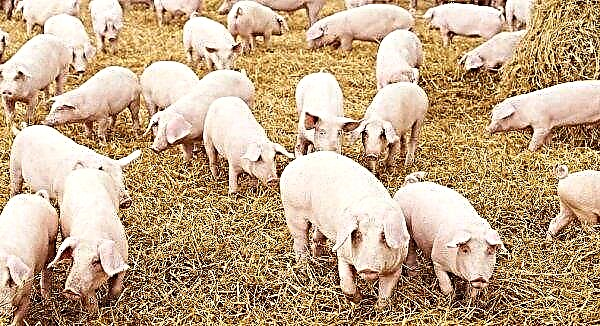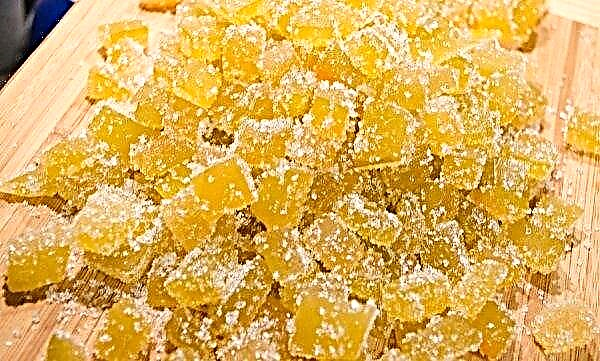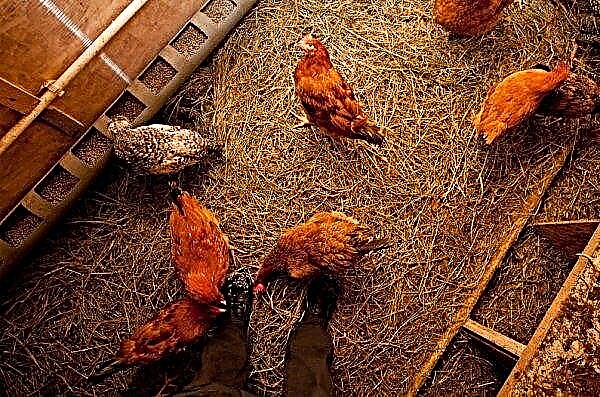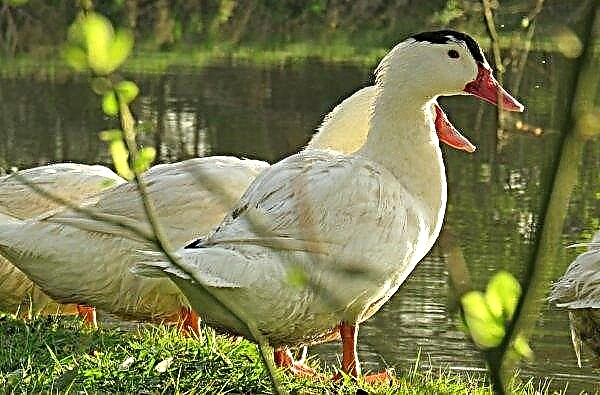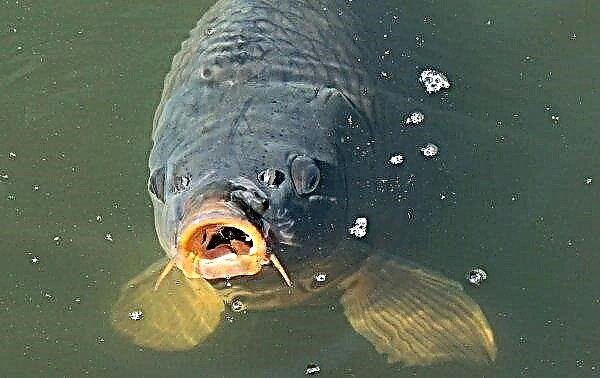A cow has been a life partner and source of human nutrition for several thousand years, during which the breeds of this animal were clearly divided into dairy, meat and mixed meat and dairy according to the benefits brought to their owner. The Hereford cow is a distinct representative of the meat breed, and for the entire time of its breeding the dairy "component" has never been given attention.
Breed description
In the 18th century, a new breed was bred in Herefordshire in the UK, through the selection and crossbreeding of the best strong cattle. The red cow was selected for breeding a suitable source of meat and traction. The tribal book was opened in England in 1846, since then the Hereford cow began to be distributed by farmers around the world.
External data
| Suit | Dark red with a white bottom from head to tail |
| Leather | Resilient, elastic |
| Wool | Light, delicate edge |
| Head | Massive |
| Horns | Small, thick, bent down or forward |
| Neck | Short, powerful |
| Withers | Wide, up to 130 cm high |
| Housing | Round, undercuts protrude |
| Chest | Large, wide (depth up to 70 cm, width up to 50 cm, girth up to 200 cm) |
| Back | Short wide |
| Legs | Tight, muscular |
Advantages and disadvantages
If we consider Hereford cows from the point of view of obtaining meat products, then they have practically no flaws - for many centuries, breeders have tried.
- Positive breed qualities are as follows:
- endurance - withstand long hauls between pastures and prolonged stay on them;
- cold hardiness - found in Siberia, the Far East and even Sakhalin;
- heat resistance - a warm climate is also not a problem for this cattle, it is kept even in Australia and New Zealand;
- large mass of animal and good lethal yield;
- fast weight gain - a one-year-old goby can weigh up to 400 kg;
- high quality of meat - “marbling” is given to the meat by thin layers of fat, due to which excellent taste is achieved;
- the quality of the skin, the elasticity and subtlety of which are used in the shoe industry and for the production of haberdashery;
- good heredity - the quality of the meat is transmitted to the offspring even when crossed with representatives of other breeds;
- rapid puberty - 1 year;
- long life - up to 18 years;
- calm nature.
- TO cons Hereford Cow can be attributed:
- low milk yields, although this is a side function of this breed, and all milk is usually spent on feeding calves;
- the need for enhanced feeding of a large animal;
- spacious conditions in the pasture - due to the large size and weight (although in the stall they normally experience crowding).
Maintenance and care
Despite all the unpretentiousness of the representatives of this breed, nevertheless, they have some conditions for the maintenance and care. For good growth, it is important to adhere to the correct conditions for the maintenance of these cows.
Important! Winter hay stocks should be significant, as the average Hereford breed is able to eat 10–13 tons of feed during the cold season.
Summer walking area
The best place to feed these cattle are summer pastures. Here, not only in abundance of feed, spacious, calm atmosphere, but also good conditions for growing young animals, transferring it from milk to pasture feed. The area is arranged in such a way that pens for adults and calves are organized around the perimeter, and a drinking bowl is arranged in the middle. It is also necessary a roofed place where animals can relax from the heat or hide from heavy rain. An open-air cage is made for young animals, where calves are fed according to a separate diet. For cows that are about to calve, and for mothers with calves before reaching a weekly age, another corral is separated.
The area is arranged in such a way that pens for adults and calves are organized around the perimeter, and a drinking bowl is arranged in the middle. It is also necessary a roofed place where animals can relax from the heat or hide from heavy rain. An open-air cage is made for young animals, where calves are fed according to a separate diet. For cows that are about to calve, and for mothers with calves before reaching a weekly age, another corral is separated.
Settlement of a barn
The cowshed for this unpretentious breed has two basic requirements: cleanliness and the absence of drafts. From this they proceed from the arrangement of the premises. It is necessary to check the entire building for cracks that are carefully caulked. As in the summer pasture, separate stalls are arranged for adults, young animals, for cows preparing for childbirth, and for mothers with small calves.
Did you know? Hereford meat is considered the best for cooking steaks in the rare (with blood) and medium rare (already bloodless, but with pink juice) categories. For this, in the first case, the meat is fried at a temperature of +50 to +55 ° C, and in the second - from +55 to +60 ° C.
Feeding troughs and drinking bowls are located in the central part of the room. Given the animal’s habit of digging and scattering food, it is better to restrict access to the feeder with a grill or fence so that it is possible to take food, but it does not work to litter. The most common feeder is a rectangular box, which is hung on the fence of the stall. Thus, it is convenient to dose food and note which pet ate how much. For liquid feed, you can use plastic containers with convenient access for the animal. The flooring is preferably made of straw, evenly distributing it with a thick layer (up to 15 cm) on the stall floor. As it becomes soiled, up to harvesting, straw is added. More "advanced" farmers use special European-made mattresses, the filler of which is components that are neutral to pathogens: foamed polyurethane, scraps of rubber, latex, wax coating. You can consider a more expensive and reliable option - rubber mats, popular in the US and Canada.
The flooring is preferably made of straw, evenly distributing it with a thick layer (up to 15 cm) on the stall floor. As it becomes soiled, up to harvesting, straw is added. More "advanced" farmers use special European-made mattresses, the filler of which is components that are neutral to pathogens: foamed polyurethane, scraps of rubber, latex, wax coating. You can consider a more expensive and reliable option - rubber mats, popular in the US and Canada.
Did you know? Cows are not at all as stupid as they might seem when watching them. These animals are quite difficult to train, but not at all because they are not smart enough, but because they simply do not want to carry out the trainer's commands that are meaningless, in their opinion.
Conditions of detention
When kept in a barn, these animals are as unpretentious as during walking on pastures. Here are the basic conditions that are necessary for the normal nutrition and growth of animals:
- Ambient temperature. Representatives of this breed are able to withstand both heat and frost, but possible drafts can harm their health.
- Lighting. Conventional industrial lighting is mounted with fluorescent lamps or their energy-saving counterparts. It is worth paying special attention to the wiring installation to exclude the possibility of an emergency situation. The top or skate of the building can be covered with transparent polycarbonate for better natural light.
- Ventilation ducts optional - there may be enough open doors and windows. But in winter, even a cold-resistant animal will be comfortable with closed doors and artificial ventilation.
 Gates and doorways in the winter are insulated with improvised means. This is done to protect against drafts, which can lead to disease even the most persistent representative of this breed. When arranging a barn, you need to think about storing pet waste products. One animal can produce about 10-12 tons of feces per year. The further use or processing of this raw material is another matter, and the reception of current waste must be foreseen immediately.
Gates and doorways in the winter are insulated with improvised means. This is done to protect against drafts, which can lead to disease even the most persistent representative of this breed. When arranging a barn, you need to think about storing pet waste products. One animal can produce about 10-12 tons of feces per year. The further use or processing of this raw material is another matter, and the reception of current waste must be foreseen immediately.Crib Cleaning
Cleaning of the premises where the burenki are located should be carried out daily so that their vital products do not decompose. Spoiled air and mass reproduction of pathogens of various infections can spoil not only the atmosphere in the barn, but also lead to diseases and even deaths in the livestock.
- Manure removal. In large farms, the removal of manure can be organized in the form of an automatic process, but on small farms this will have to be done with the help of small tractors, walk-behind tractors or the old fashioned way - manually with a fork, shovel and rake.
- Cleaning feeders and drinking bowls. Food and water stagnation is a good breeding ground for pathogens that can infect a cow. During cleaning, these containers should be cleaned very carefully so that food remains do not linger on the external and internal surfaces of the inventory.
- Flooring Replacement. The straw flooring is topped up 1-2 times as it becomes soiled, after which it is raked with a pitchfork or a mini tractor and used as fertilizer for the garden. The floor is washed with water under pressure and dried, if necessary, disinfection is carried out and a new litter is laid.
Important! Cow dung is an excellent fertilizer, it can be used for your own farm needs or sold to villagers, summer residents or other farmers, making good profit.
Feeding ration
Hereford breed perfectly adapts to the conditions of detention. At the same time, mass growth is observed even in extremely "Spartan" conditions.
Summer walk in the pasture
For Hereford cows, grazing is the best way to gain weight - lush meadow forbs, free movement and a relaxed atmosphere help not only to gain weight, but also to grow their offspring. Staying in different climatic zones is not a problem for representatives of the species - they tolerate heat and cold equally well. Animals remain calm with poor nutrition, for example, in the foothills. In difficult times, weedy, hard and dry plants eat. At the same time, there is no competition between them for more delicious food.
Differences in winter feeding
The main food for the representatives of the breed is hay of cereals and legumes, which the owners harvest for future use in the winter. During the monotonous eating of hay in winter, animals need to be pampered with various top dressings:
- trace elements (calcium, phosphorus, protein top dressing);
- succulent fodder - plants of autumn mowing that have sunk (but not rotted!);
- neutral vegetables - beets, turnips;
- salted barley;
- silage;
- coarse bran.
Water
Drinking bowls with water should be freely available for these ungulates - animals need the opportunity to quench their thirst when such a desire arises. The temperature of drinking in the summer is not regulated - from cool to warm, depending on the weather and time of day. But winter drinking needs to be warmed up so that the pets do not get too cold. It is necessary to pay attention to the purity of water so as not to infect cows with intestinal infections and helminths. Hereford cows are an excellent livestock breeding cattle. With proper care for these meek creatures, they will demonstrate stable weight gain and give quality offspring.
Hereford cows are an excellent livestock breeding cattle. With proper care for these meek creatures, they will demonstrate stable weight gain and give quality offspring.

